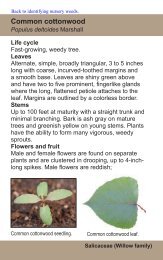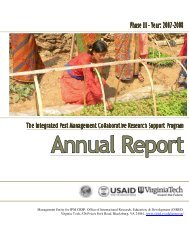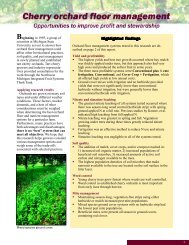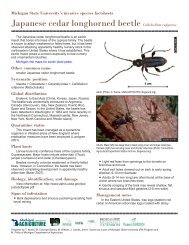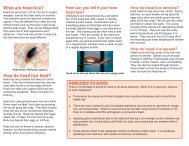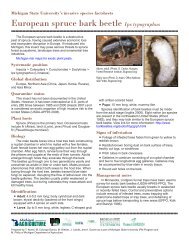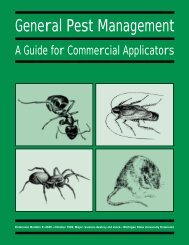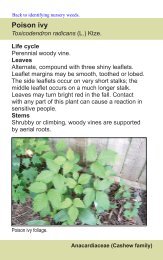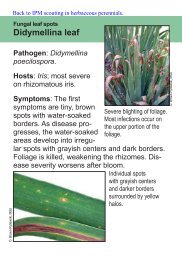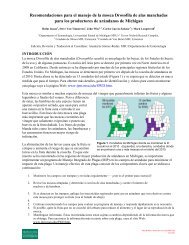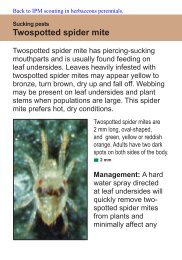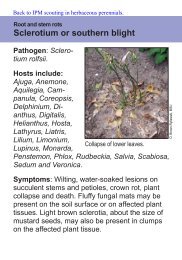Whole Manual - Michigan State University: Integrated Pest ...
Whole Manual - Michigan State University: Integrated Pest ...
Whole Manual - Michigan State University: Integrated Pest ...
You also want an ePaper? Increase the reach of your titles
YUMPU automatically turns print PDFs into web optimized ePapers that Google loves.
Pathogen type: bacterium (Xanthomonas campestris pv.<br />
campestris)<br />
Disease symptoms: Infected seedlings turn yellow and<br />
die. Symptoms on older plants include yellow, wedgeshaped<br />
areas at the leaf margins. The affected areas<br />
expand toward the center of the leaf, turn brown, and die.<br />
The veins become discolored at the leaf margins and the<br />
discoloration extends toward the base of the plant. The<br />
head is stunted, and symptoms are frequently more<br />
severe on one side of the head.<br />
Environmental conditions favoring disease: The optimum<br />
temperature for disease development is 80 to 86<br />
degrees F, and either rain or persistent dew is required.<br />
The bacteria overwinter on and in seed and debris from<br />
diseased plants left in the field. They spread by splashing<br />
water, on wind blown leaves, or by handling infected<br />
plants.<br />
CLUBROOT<br />
ALTERNARIA LEAF SPOT<br />
Clubroot causes wilting (top) and enlarged plant roots<br />
(bottom).<br />
Alternaria can also cause head rot in cabbage.<br />
Pathogen type: fungus (Alternaria spp.)<br />
Disease symptoms: Spots with dark, concentric circles<br />
form on lower leaves. In moist weather, a dusty fungal<br />
growth occurs on the spots.<br />
Environmental conditions favoring disease: Disease<br />
development is favored by cool, wet weather. The fungus<br />
overwinters in seed and diseased crop residues.<br />
Pathogen type: fungus (Plasmodiophora brassicae)<br />
Disease symptoms: Infected plants yellow and wilt. The<br />
roots are enlarged and “clubbed.” Young plants can be<br />
killed; mature plants will not produce a marketable crop.<br />
Environmental conditions favoring disease: Clubroot<br />
thrives in cool, wet soils. This soilborne fungus can<br />
remain viable indefinitely in the soil.<br />
DOWNY MILDEW<br />
Plants infected with downy mildew can have a white, fuzzy<br />
appearance.<br />
Vegetable Crop <strong>Pest</strong> Management 65<br />
Chapter 7



